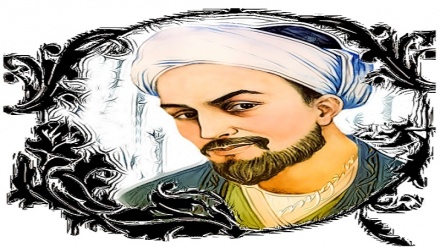Iranian notables, sources of global honor (82)
Today, we become familiar with the treatise named “Aql-e Sorkh” penned by the renowned Iranian mystic and philosopher, Sheikh Shahab Ed-Din Sohrawardi. Do stay with us.
It was said that Sheikh Shahab Ed-Din Sohrawardi is the acclaimed and preeminent Iranian philosopher and mystic who lived in 6th Century AH. Today, we continue to study the works and services of this renowned figure, which highly contributed to Islamic philosophy and mysticism. He is the founder of one of the most important Islamic philosophy schools of thought, referred to as “Illuminism”. This celebrated Islamic philosopher earned the title of Sheikh Ul-Eshraq.
Sohrawardi was born in the Sohraward Village, in the vicinity of city of Zanjan in the year 549 AH. He was killed at the age of 38 in the year 587 AH, upon the conspiracy hatched by the scholars in the city of Aleppo, by the order of the Founder of Ayoubi Dynasty, Salah Ed-Din Ayoubi. He authored several books in his short life; which have remained to this day. Some of the works of this Iranian philosopher are in the form of treatises and stories, penned in allegorical and cryptic style, which according to researchers depict the true image of this acclaimed philosopher. This group of works has been written in a delicate, beautiful, and cryptic style, presenting the inner and spiritual experiences of this well-known and well-established mystic. In the past few weeks, we got to know treatises such as “The Chant of Gabriel’s Wing”, “Loghat-e Moran”, “Fi Haqiqat al-Eshq”, and “The Calling of the Simurgh”, which are some of the Farsi works of this philosopher in cryptic and figurative style. Today, we study another treatise of this Iranian philosopher, named: “Aql-e Sorkh”.
Researchers of the works and thoughts of Sohrawardi opine that Aql-e Sorkh is one of the most cryptic and accredited allegorical treatises of Sohrawardi. It is one the treatises which summarizes the personal views and thoughts of this famed Iranian mystic. The French Orientalist, Henry Corbin, has translated many of the works of this famed Iranian mystic into French language, including the treatise “Aql-e Sorkh”. The French Author and Playwright, Eugene Ionesco, upon reading the translated transcript of this treatise in French language, wrote a letter to Henry Corbin, pointing out to the latter that this treatise is one of the main and most miraculous texts on spiritual existence which has been introduced to the West. The French playwright added that this treatise maintains a difficult and complicated text which should be read precisely and thoroughly. The French playwright noted that whenever he loses the right track, the notes and elaborations presented by the French Orientalist, Henry Corbin, in the translated text of the said treatise helps Ionesco to return to the right track. The French playwright ends his remarks by underlining that he may never need to read any other book after reading this comprehensive treatise, while he will continue to read this treatise again and again in the future.
According to contemporary Iranian researcher, Dr. Ibrahim Dinani, the renowned Iranian mystic, Sohrawardi, was highly influenced and inspired by Iran’s famed Poet, Ferdowsi, in elaboration of his views. According to this contemporary researcher, Sohrawardi was inspired by Ferdowsi’s collection of poems, Shahnameh, which the former had most probably read several times. However, given that one of the characteristic features of Sohrawardi’s writings is their cryptic style, he never mentions his sources of inspiration. He has done this intentionally and has therefore not mentioned the name of Ferdowsi. According to this contemporary researcher, this measure of Sohrawardi could have had political and social reasons.
Sohrawardi, in the treatise named: “Aql-e Sorkh”, is highly inspired by ancient Iran’s culture. In the view of another Iranian contemporary researcher, Dr. Abul-Qasem Ismailpour, the renowned Iranian mystic, Sohrawardi, in five of his treatises, including “The Calling of the Simurgh”, and “The Chant of the Gabriel’s Wing” has directly made use of ancient Iran’s legendary themes.
According to this researcher, and many other researchers, Sohrawardi, in his allegorical stories, has made use of themes, and legendary characters which have been mentioned in the Zoroastrians’ book “Avesta” and Ferdowsi’s collection of poems “Shahnameh”. In fact, Sohrawardi has made use of cryptic and symbolic stories to prove his philosophical goals. At times, he has made use of cryptic allegories related to light and darkness, which originate from ancient Iranian themes.
He has made use of legendary characters and has presented a number of conclusions from his mystic and philosophical discussions with the assistance of these characters.
According to Dr. Ismailpour, the legends presented in the treatise named “Aql-e Sorkh” are the products of Sohrawardi’s creative mind.
Given the inclination of communities toward surrealist stories; some critics opine that some of Sohrawardi’s cryptic stories, including the treatise named “Aql-e Sorkh” maintain the capacity to be source and role model of surrealist anecdotes and post-modernist tales. By reading this treatise, we are familiarized with modern and surrealist stories. In fact, by reading such stories, one realizes the richness of Farsi literature in regard to presentation of imaginations and cryptic language.
MR/ME


